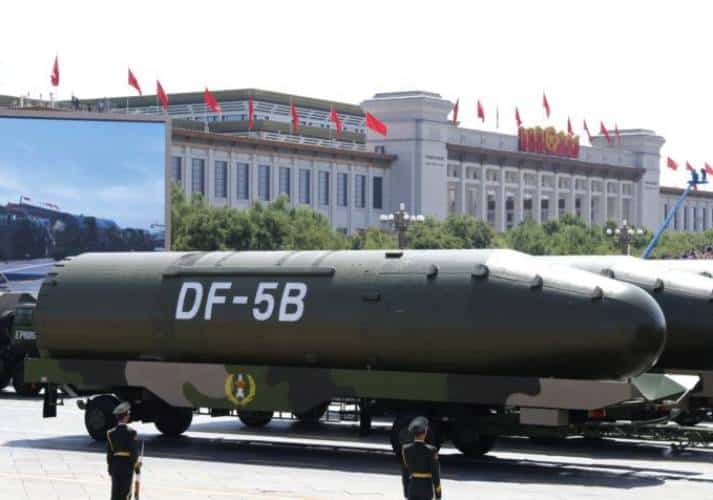
The anxiety of nuclear annihilation was the specter that loomed over the Cold War. Though things seem a lot calmer nowadays, there are still some 17,000 intact nuclear warheads around the world, according to recent estimates. About 7,000 of these warheads are awaiting dismantlement but that still leaves us with a mind boggling 10,000 armageddon-causing bombs idly waiting for their launch codes. That sounds like an absolute nightmare — and that’s no coincidence.
Why are we still alive?
Throughout the Cold War and even well into the post-Cold War era, nuclear powers have relied on a deterrence doctrine. The argument says that if a nation has the capability to inflict unacceptable damage on another, then the latter will refrain from attacking the former—it will be deterred from doing so. This scenario is often called MAD short for Mutually Assured Destruction. Essentially, deterrence relies on holding the entire civilian population hostage. It’s like having peace between two people aiming guns at each other, both finger on the trigger. This is precisely why North Korea, for instance, has invested so many resources into its nuclear program. What’s arguably the most authoritarian regime in the world knows very that the only way it can ensure its existence is by having a big gun pointed at everyone else — just like everyone else has already been doing it for decades.
So, why are we still alive? That’s a good question. The reason why all-out nuclear war hasn’t begun yet is that deterrence generally works but only as long as the players involved act rationally. But since humans are rational yet also deeply emotional beings, simply consider it a miracle you’re still alive. In 1983, peace in the world hinged on the make-or-break decision of a single person, and there are other similar examples of when things had gotten way too hot.
What’s concerning is that some nuclear powers have shifted towards a tactical doctrine where it’s deemed acceptable to use limited nuclear strikes, such as to put an end to a conventional war. The thinking is, well, one bomb couldn’t hurt, right? A new study recently published in Environment Magazine says otherwise. The authors of the paper found even as few as five conventional nuclear bombs are enough to trigger dramatic changes in the climate or so-called ‘nuclear autumns’.
You might have heard the term ‘nuclear winter’ before. It describes the climate effects of nuclear war as a result of debris and smoke — especially black, sooty smoke from burning cities and industrial facilities — that block out the sun for years. What results are cool, dark, dry conditions that would prevent crop growth for at least a growing season and likely many years after the first bombs were triggered. The social impact is not difficult to predict: mass famine throughout the world. More people might die in noncombatant countries than in those where the bombs exploded because of this effect. Even a nuclear war between India and Pakistan — two neighboring countries which view each other as nemesis — could produce so much smoke that it would produce global environmental change unprecedented in recorded human history. A ‘nuclear autumn’ isn’t as devastating as a nuclear winter but it’s still bad. Sad, as someone who actually has the launch keys for American nuclear warheads might say.

The team at the University of Nebraska-Lincoln analyzed records on 19 types of nuclear weapons held by only five nuclear powers: the USA, Russia, China, the UK, and France. They looked at virtually all the possible types of modern nuclear bombs and of varying magnitudes, from missiles to land-based missiles to air-dropped ones. Based on this data, the scientists calculated how many bombs that fall in each category of strength would be enough to trigger a nuclear autumn.
The conclusion was stark. The US, Russia, and China all have weapons that could trigger a nuclear autumn by detonating no more than five bombs. China’s DF-5 ICBM, armed with a single 5-megaton warhead, can alone trigger a nuclear autumn. If the DF-5 were to be detonated over Los Angeles, the 5 megaton warhead would have a fireball more than two miles wide, and guarantee third degree burns 15 miles from the point of detonation.
“The use of only one 5-MT land-based missile deployed by China could burn an area similar in size to that of one hundred 15-KT explosions. Alternatively, if the United States dropped only three 1.2-MT bombs, or used two Trident D5 SLBM (each with four 475-KT warheads), the size of the explosions would exceed the land area required to produce similar climate impacts. Use of only four 800-KT Russian ICBMs or ten 300-KT French gravity bombs would also have similar climate impacts. Thus, use of as few as 1 to 10 deployed nuclear weapons, and fewer than 25 of these prevalent types, from the five official nuclear weapons countries could produce a nuclear drought,” the authors wrote.

I can only hope some of the ‘bright minds’ in charge who are thinking about using nuclear weapons for tactical purposes are reading this.
“Nuclear policy analysts have found recent troubling developments in the policies of Russia, Pakistan, and India concerning the first use of nuclear weapons. Many analysts agree that the shifting nuclear force postures and doctrines of these states makes a limited nuclear exchange much more probable to occur. Pakistan and India have come close to a regional nuclear exchange three times in recent decades,” the authors caution.
“As long as conventional nuclear weapons are prevalent, the breadth of existing research indicates that the question is not whether a nuclear drought can occur, but what factors increase its probability of occurring and what actions can be taken to mitigate the potentially devastating global impacts,” they concluded.
So what do we do? Some might argue we should ban the damn things once and for all and lo and behold on July 7, almost 72 years after the first atomic bomb was detonated in the New Mexico desert, 122 nations voted at the United Nations headquarters in New York to permanently ban nuclear weapons under international law. That would have sounded extraordinary were it not for the fact that not one single state of the nine that possess nuclear weapons even attended the negotiations. The ban treaty will be open for signatures from all UN member states beginning in September and will officially enter into force after 50 states have accepted it. So what happens in the ban enters force and, predictably, Russia or the USA refuse to dismantle their arsenal? Nothing — but at least someone’s trying.






